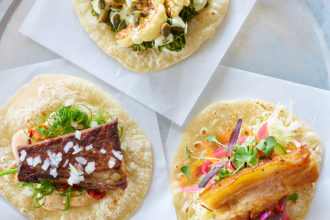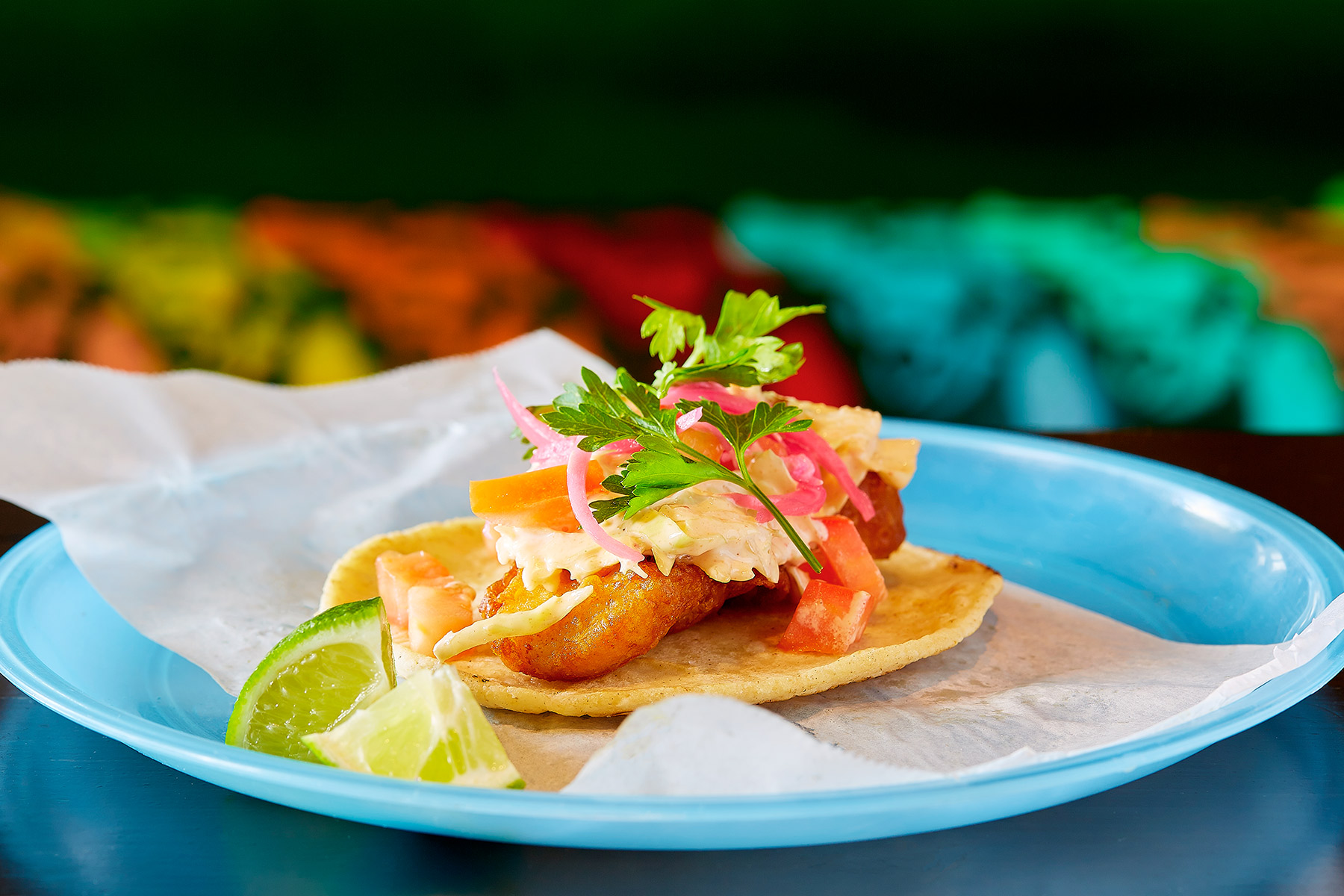A flurry of words went down on the subject of Mexican food on Monday. And this as I was preparing to write about the masa situation in Dallas, and even as my July issue reviews of two new taquerias—Revolver Taco Lounge and Taquero—hit both the web and the stands. (I had asked for an extra page for our monthly Newcomer feature, something I haven’t done since I started writing that column.)
Meanwhile, it’s been a time for the discussion of modern Mexican elsewhere. Julia Moskin of The New York Times wrote last month about a Mexican-American chef in Copenhagen, the article’s title “’Modern Mexican’ Steps Into the Spotlight” (note the quotation marks around the operative part of the title). Both Pete Wells and Jonathan Gold reviewed modern Mexican restaurants in New York and Los Angeles, respectively, two cities where modern Mexican cuisine has taken firm hold. Wells praises the “dreamscape vision” of Mexican food he found at Empellon, while Gold ended his review of Maestro saying, “sometimes you want Mexican cooking to be more soulful than precise, to smack you across the head with intensity, funk and heat.”
And then there’s the whole controversial business of Rene Redzepi opening a pop-up of Noma in Tulum. (And Pete Wells refusing to write about it. And so on.) This title of a review by Eater LA’s Bill Esparza may be my favorite of the last few months: “Diego Hernandez Wants to Introduce Modern Mexican Cuisine to Los Angeles” (as though this were an “introduction”; hmm), with the subtitle, “Like Verlaine’s poetry, Baja cuisine requires a bit of understanding.”
The Dallas Morning News’ Leslie Brenner and Dallas Observer food scribe Brian Reinhart approach the issue from two different perspectives. In her column last week, Brenner begins with an invocation of halcyon days, when El Bolero was a new-ish promising star and Madrina was launching an ambitious French-Mexican remix with gorgeous attention to detail and technique. In his piece from Monday, Reinhart counters and ends with what is admittedly a solid round-up of hole-in-the-wall spots in Oak Cliff where regional—and other—Mexican cooking is thriving. Their respective claims:
- Modern Mexican: I’m not seeing it.
- Brenner has blinders on.
Brenner’s argument comes to me at an odd time and with a bizarre tone. It feels like it’s an argument stuck in the  past. I wrote about Madrina as a Best New Restaurant in 2015 and now it’s closed. Conversely, Flora Street Café was my Best New Restaurant for 2016, and it is alive and well. The irony for me, also, is that Brenner writes this just at the time when I think our scene is beginning to have the new burst of creative energy she finds lacking. Or at any rate, that we are having the conversation. As I discuss in my review of Revolver Taco Lounge, the notion of modern Mexican cuisine is at the center of what Regino Rojas and Hugo Galvan are aiming for with their stage-piece octopus and duck breast tacos, hand-pressed tortillas, moles, and traditional soups served with dots of guava puree or dabs of pureed tortilla ash.
past. I wrote about Madrina as a Best New Restaurant in 2015 and now it’s closed. Conversely, Flora Street Café was my Best New Restaurant for 2016, and it is alive and well. The irony for me, also, is that Brenner writes this just at the time when I think our scene is beginning to have the new burst of creative energy she finds lacking. Or at any rate, that we are having the conversation. As I discuss in my review of Revolver Taco Lounge, the notion of modern Mexican cuisine is at the center of what Regino Rojas and Hugo Galvan are aiming for with their stage-piece octopus and duck breast tacos, hand-pressed tortillas, moles, and traditional soups served with dots of guava puree or dabs of pureed tortilla ash.
Reinhart’s solution of a tour of Oak Cliff will never fully satisfy Brenner’s complaint. It’s comparing apples to oranges. And this in part because what they’re both talking about is a slippery thing, that part of the above-mentioned NYT article title that appears in quotes. No one ever quite defines what modern Mexican is. What is modern Mexican? We’re throwing around the term like everyone already knows what it means.
To me, the movement that gained its star in the figure of Enrique Olvera, who opened Pujol in Mexico City in 2000, is a blend of two currents: 1) the modern, what you might call innovation and creativity, and 2) the fundamentals. Within the context of this movement, we saw chefs who began studying ancient regional roots and crossing them with techniques that, in greater or lesser ways altered them. Modern Mexican would be made with quality ingredients, it was clear. This did not mean lobster, necessarily. But this might mean pulpo—octopus—treated beautifully. This might mean lengua—beef tongue—cooked sous-vide as Jesus Carmona does at Tacos Mariachi, for a tenderness that’s absolutely remarkable.
Modern Mexican isn’t going to be synonymous with the humbler, more traditional (that is, fonda-style or street-style) cooking, though it will borrow its forms. And borrow, too, its deep rootedness in a culinary heritage. Modern Mexican, to me, is about going back to fundamentals. That means to masa and to the sauces that have made Mexican cuisine recognized as a world heritage treasure. It means going to the wealth of local, often indigenous ingredients, shedding light on the vast and beautiful differences between chiles. It takes familiar flavors and preparations and sheds new light on them. What it has in common with more fonda-style Mexican cooking is an understanding and respect for process and various harmonies. And part of it too, for me, is about pride and respect, though this of course is one of those intangibles.

The respect for Mexico I see in Resident Taqueria’s tacos, where Andrew Savoie has been interested in making tepache, the ancient fermented pineapple beverage, since they opened (and, of course, serving it in cocktails). At Resident, refried beans are a smooth, sable cream nestling garlic confit; his crispy kale taco, on fresh-pressed flour tortillas, wears a lemon-epazote aioli. Is this modern Mexican? I say, yes.
Flora Street Café’s silky avocado flans and chapulines puffs are beguiling and, at times, riveting in their reinterpretations. But I also see skillful remixes elsewhere: just as beautiful are inventive sides like the fried Brussels sprouts with dried hibiscus blossoms, which I described at length in my review of Taquero, where what I’m most intrigued with is the way Fino Rodriguez, who helped develop the menus for Mesero, uses the chewy blossom that we otherwise see most often in the form of tart-sweet, maroon agua fresca. (I hadn’t found the blossoms used in quite this way since the hibiscus enchiladas I ate several years ago in Mexico City, at a restaurant, in fact, that was part of that cradle from whence emerged what has gone on to be dubbed “modern Mexican.”)
And some of the more exciting things here overlap with and are happening in the world of masa: Fino Rodriquez of Taquero making a blue-corn tortilla from purply-blue corn brought to him from his home region of San Luis Potosi; Revolver Taco Lounge’s freshly hand-pressed tortillas not nixtamalized in house, but griddled in front of you on the comal before becoming the canvas for the frizzled leeks and lush sauces. One of the things you need, first and foremost, is chefs with passion and a desire to engage with the fundamentals in creative ways. I think we’re seeing that.
And so, what Andrea Pedraza is doing with her new bars of bean-to-bar chocolate at CocoAndre, where their Oaxacan-style chocolate from beans from a cooperative in Peru is toasted, winnowed, and hand-ground in a molino and accented with hibiscus salt and pepitas, a perfect note of chiles making it dark, wild, and spicy—is that modern Mexican? I say, yes.
Should we know regional Mexican cuisine better than we do? Yes. I roundly criticized Komali the last time I reviewed the restaurant for dumbing down what had once been a far more exciting menu. And certainly we, as diners, have a ways to go before we’re able to support a roster of places that show us the finer differences between the cuisines of Michoacan, Veracruz, San Luis Potosi, the Yucatan, or Oaxaca.
I hear the call to arms. But I disagree that we’re not already seeing it here. Do I think there’s room for more innovation? Yes. Are we moving in the right direction? Yes. I think we are. In her article about the cooking happening under the term “modern Mexican,” Moskin writes, “the struggle over authenticity may be giving way to something more rewarding: a worldwide conversation about Mexican food that is respectful and inquisitive.” This, to me, is the foundation. Until then, you can find me chasing hibiscus blossoms at Flora Street Café and Taquero.





